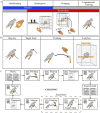A Bird's-Eye View of Regulatory, Animal Care, and Training Considerations Regarding Avian Flight Research
- PMID: 30764892
- PMCID: PMC6591680
- DOI: 10.30802/AALAS-CM-18-000033
A Bird's-Eye View of Regulatory, Animal Care, and Training Considerations Regarding Avian Flight Research
Abstract
A thorough understanding of how animals fly is a central goal of many scientific disciplines. Birds are a commonly used model organism for flight research. The success of this model requires studying healthy and naturally flying birds in a laboratory setting. This use of a nontraditional laboratory animal species presents unique challenges to animal care staff and researchers alike. Here we review regulatory, animal care, and training considerations associated with avian flight research.
Figures





References
-
- Animal Welfare Act as Amended. 2008. 7 USC §2131–2156. USA.
-
- Animal Welfare Regulations. 2008. 9 CFR § 3129.
-
- Asher L, Davies GTO, Bertenshaw CE, Cox MAA, Bateson M. 2009. The effects of cage volume and cage shape on the condition and behaviour of captive European starlings (Sturnus vulgaris). Appl Anim Behav Sci 116:286–294. 10.1016/j.applanim.2008.10.008. - DOI
Publication types
MeSH terms
LinkOut - more resources
Full Text Sources

